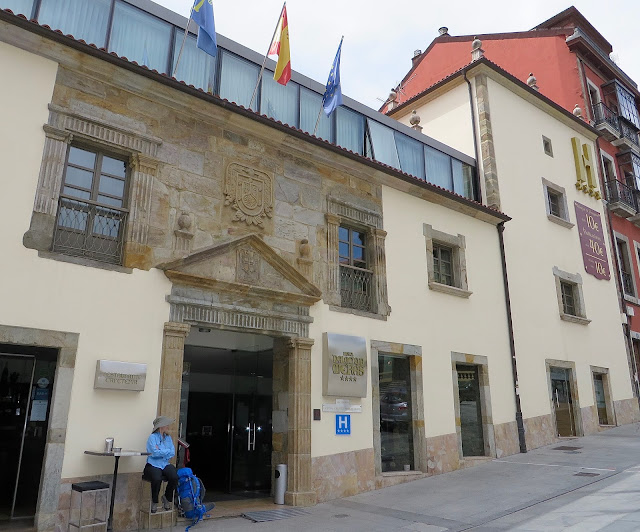Albergue de Miguel provided a breakfast of cereal and small biscuits. I was joined by French walking friends who were born on the same day but different years. The pilgrim on the right showed me cell phone pictures of the Grand Canyon that were sent to him by his son who recently traveled in the U.S.
I left Salas once light broke. The way out of town passed
a highway structure that loomed large overhead.
"Cuidado Con El Perro" -- Beware the dog
This arrow design was painted on markers and walls along the Primitivo. Perhaps the circle eight design represented the infinity sign, a symbol for the concept of limitlessness.
Old bathtub = water trough
Small churches, or capillas (chapels) on the Primitivo are identified with signs that include the name and date founded. My favorite was 15th c. Capilla del Cristo de los Afligidos (Chapel of the Holy Christ of the Afflicted) located in Pereda near Tineo. It had been affiliated with a pilgrim hospital established by Benedictine monks.


A hoop for Dad
A 'mini-horreo' functions
"Potable Agua" along the Road -- always appreciated!

Some homeowners offer food & beverages for sale to walkers -- it's an economic opportunity, especially in small towns or rural areas. This house had its own cart and seating area. I often buy something to help support these businesses & entrepreneurial spirit. Here I bought a Kas limon drink & bag of chips.
The path involved navigating many
muddy stretches.
Tineo was founded by the Romans, and during the Middle Ages it encompassed a pilgrim hospital, Franciscan monastery, and castle. In 1222 King Alfonso IX declared the town a mandatory pilgrimage stop.
On the edge of Tineo in Santa Eulalia de Tineo a metal pilgrim stood along a walkway called the Paseo de los Frailes, or the Friars' Walk. This "Monumento el Peregrino" (Pilgrim Monument) includes a sundial in the shape of a shell. The Latin words on the sundial translate as "Wayfarer look at the hour & continue on your way."
Also located in Santa Eulalia de Tineo was Ermita de San Roque originally built in the 13th c. & remodeled in the 16th c. A crest with shells decorates the entrance. St. Roque is known as the patron saint of pilgrims. He gave away his belongings to become a mendicant pilgrim to Rome where he administered to the sick. Falling ill himself, he was exiled and miraculously healed by a dog who licked his wounds. Thus, St. Roque is also the patron saint of dogs and dog lovers -- my kind of guy!
In Tineo I stayed at the 4 star Hotel Palacio de Meras located in the town's 16th c. palace. The hotel has a basement floor for walkers with beds at the bargain price of 10 Euros.
The pilgrim floor was divided into cubicles of 2-4 beds each. I got my own cubicle because of being solo. It was nice to have a private space!
The hotel's restaurant offered a pilgrim's meal in their Renaissance style dining room. Joining me at dinner was Daniel from Italy on break from university studies in economics and walking his first Camino.
View of the Plaza del Ayuntamiento across from the hotel
The Ayuntamiento, or city hall, kitty corner from the hotel



































No comments:
Post a Comment